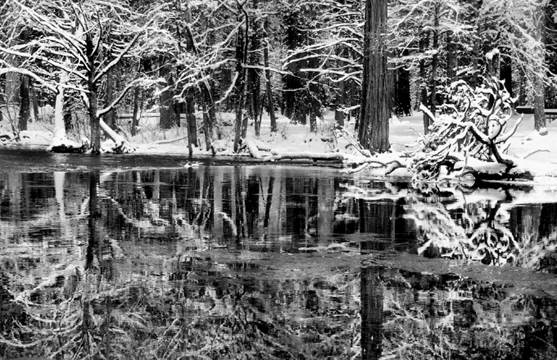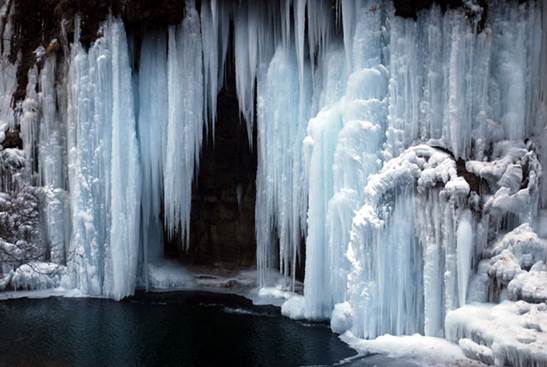4.
Close-up on icicles
Wherever small quantities of water drip
away continually you’ll find icicles forming in cold weather. This can be
anywhere from a leaky gutter to car bumpers to rocky ledges and overhangs, and
they vary in size from a few millimeters to several meters long. For small
icicles, move in tight and fill the frame, capturing reflections in the ice. If
they’re on a bigger scale, use a wide-angle lens from close-up to exaggerate
there size. The most dramatic icicles are found on overhanging cliffs that you
can get behind and use to frame the scene beyond.

Wherever
small quantities of water drip away continually you’ll find icicles forming in
cold weather
5.
Start early
Snow, frost, ice and mist are all at their
most photogenic when they’re fresh and the air temperature remains low. As soon
as temperatures rise, everything melts and fades away. Early morning is when
winter days are usually at their coldest, so to make the most of the conditions
get out there at first light. Pre-dawn light has a magical quality, with images
taking on a moody blue hue, while winter sunrise can be stunning. Your location
is likely to be quiet at this time of day, too.

Snow,
frost, ice and mist are all at their most photogenic when they’re fresh and the
air temperature remains low
6.
Convert to black & white
The winter landscape is stark and barren.
Snowfall covers many of the features you’d normally see, trees stand skeletal
against the sky and the weather can be dark and foreboding. This combination of
factors makes winter an ideal time to try your hand at black & white
photography often there will be so little color in the scene that your images
look monochromatic anyway! The key is to be bold – boost contrast to really
make the most of the light/dark combination of tones so often seen in the
winter landscape. Applications such as Silver Efex Pro 2 by Nik Software make
black & white conversion quick, easy and amazingly effective.

This
combination of factors makes winter an ideal time to try your hand at black
& white photography
7.
Lightworks
The quality of light can make or break a
great winter image, especially a color one. Fortunately during winter, light is
often very good. The color temperature of the light remains relatively low (and
warm) all day because the sun doesn’t climb far above the horizon. This also
means that shadows are long in winter sunshine, and weak, too, as the light
lacks the intensity of summer. Keep an eye on the weather forecast and if dry,
sunny conditions are predicted, get up early and shoot until dark – you can
produce a lot of great images on a good winter’s day, despite the sun only
being up for around eight hours.
8. Frozen waterfalls
It’s hard to imagine temperatures getting
so low that moving water can actually freeze, but it does happen, and the
results can look amazing! Waterfalls usually freeze over time, bit by bit.
Often you’ll still find some water flowing between or behind the ice, but it’s
not unknown for them to freeze up completely and create a wall of patterned ice
or giant icicles. Where there is water flowing still, include it as a contrast
with the ice and use a slow shutter speed of ½-one second to blur its motion.
If everything is frozen, fill the frame with ice patterns, and if you’re lucky
enough to be able to get behind the curtain of frozen water, shoot it backlit
by the sun.

Waterfalls
usually freeze over time, bit by bit
9.
Fill the foreground
Nothing beats a big and dramatic wide-angle
scene for capturing the drama and beauty of a winter landscape, so keep your
eyes peeled for suitable candidates when out shooting. Foreground interest is
particularly important. Look for snow-covered boulders, footprints in the snow,
patterns in ice or water flowing around frozen rocks, then get in low and close
with your wide-angle lens to exaggerate perspective. If you stop the aperture
down to f/11 or f/16, you’ll be able to record the entire scene in sharp focus.
For added drama, turn your camera on its side and shoot in portrait format to
include more of the foreground detail.
10.
Hoar frost
Hoar frost is formed when rapid heat loss
on clear winter nights causes objects to become cooler than the air, so any
moisture in the air freezes on contact with their cold surface. The results are
spectacular, with even the finest details – twigs, blades of grass, fence wires
and cobwebs – covered in tiny ice crystals. It normally forms overnight, so
early morning is the best time to catch it, and as it usually occurs in clear
weather, once the sun rises it will soon melt away.

Hoar
frost is formed when rapid heat loss on clear winter nights